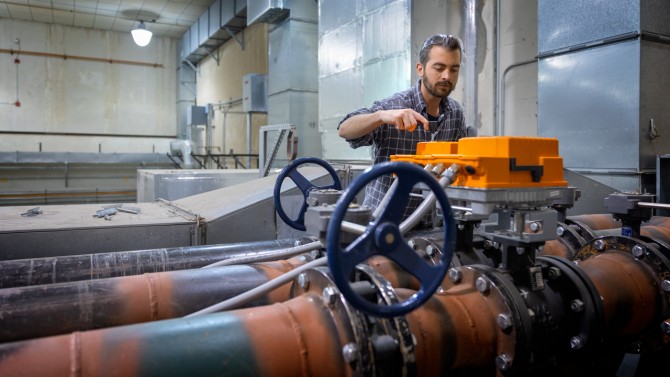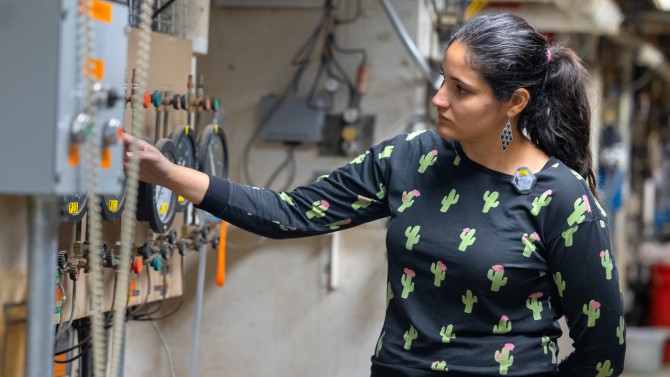Wilson Laboratory, which houses the Cornell High Energy Synchrotron Source, has tapped into the university’s Lake Source Cooling system, which draws cold water from the depths of Cayuga Lake to remove heat from the district chilled water loop that cools the majority of Cornell facilities.
Lake Source Cooling brings sustainability, precision to synchrotron
By David Nutt, Cornell Chronicle
The science of flinging around X-rays, electrons and positron beams to study the secret life of matter requires a tremendous amount of energy. It also requires a constant supply of cool water to keep the technology functioning consistently and prevent it from overheating.
For decades, the Wilson Laboratory, which houses the Cornell High Energy Synchrotron Source (CHESS), has relied on four immense cooling towers that evaporate 10,000 gallons of water daily to reduce the temperature of the nearly 650 electromagnets – some roughly twice the size of a human being – that line a half-mile-long ring buried 40 feet below a scenic swath of east campus.
Those towers are now obsolete because the lab has tapped into the university’s Lake Source Cooling (LSC) system, which draws cold water from the depths of Cayuga Lake to remove heat from the district chilled water loop that cools the majority of Cornell facilities. For Wilson Lab, this approach is not only more efficient and sustainable – it will bring greater precision to its experiments. LSC will also, for the first time, enable CHESS to operate year-round.
“Any load incorporated into Lake Source Cooling is a huge win for any comparative cooling function we can look at,” said Cole Tucker, director of utilities distribution and energy management for Facilities and Campus Services. “Lake Source Cooling, at its core, is about six times more efficient than any traditional chilled water plant. So that’s pretty amazing. It’s a very reliable system and has low maintenance requirements.”
The use of LSC will annually save the university 4 million gallons of water usage and $50,000 in electricity costs, Tucker said.
“Synchrotron X-ray facilities all have to be updated and rebuilt every 10 or 20 years,” said Joel Brock, director of CHESS. “A key goal for the next generation is to become environmentally friendly. How do you reduce your power consumption? How do you reduce your carbon footprint? Because these are large machines, you consume a lot of resources. CHESS is very fortunate to be on the Cornell campus where we can take advantage of Lake Source Cooling and the university’s leadership in exploring novel, alternative ways to heat and cool that have begun to minimize our impact on the planet.”
A constant evolution
The synchrotron’s adoption of LSC is the latest development for a facility that has been continuously evolving since the lab was bored out like a subway tunnel, five stories underground, in 1967. What began as a “straight physics experiment” to slam electrons into fixed targets, Brock said, expanded through a series of upgrades over the years to include high luminosity electron-positron collisions (positrons are the anti-matter component to electrons), high-energy physics and X-ray experiments. By 2008, the lab had phased out particle collisions and transitioned solely to leveraging synchrotron radiation for X-ray research.
Now, construction is underway on a new adjacent experimental hall that will host a $32.6 million high magnetic field project, scheduled to open in 2025.
“We are doubling our experimental floor space and constantly upgrading,” Brock said. “So in one sense, we’ve been here since the mid-60s. In another sense, we’re brand new in the last two or three years.”
Despite all the growth, many of the lab’s original systems and infrastructure are still in place. The cooling towers, installed in 1989, are located in a low-set cluster of windowless, brick buildings – the only visible evidence of Wilson Lab from Campus Road. The towers and the heat exchangers they contain are so old that lab staff have had difficulty finding replacement parts for them. And that isn’t the only challenge.
“Right now, our cooling towers are a bit problematic,” said John Barley, the Cornell Electron Storage Ring (CESR) technical director at the Cornell Lab of Accelerator Sciences and Education (CLASSE). “They can freeze in the winter, and they just don’t operate effectively in the real hot, humid summer days. So if you get rid of those two extremes, then we can operate more throughout the year.”
The facility shuts down from June until early October, which means summer is off limits for the approximately 1,000 researchers a year who rely on CHESS for their experiments.
The synchrotron consists of three particle accelerators: a linear particle accelerator (LINAC), the booster synchrotron and CESR. Each accelerator piggybacks off the other. A low-energy particle beam is launched via the LINAC, then accelerated through approximately 3,000 turns in the synchrotron before entering the storage ring, where that process repeats over and over again at 60 times per second.
As the positrons whirl around the machine, they radiate the X-rays, which hit whatever sample material is being studied with an incredibly intense, highly focused beam that is smaller than the width of a human hair, yet contains “ten million times more X-rays than the machine your dentist uses to look at your teeth,” Brock said. “This allows scientists to perform their precision measurements.”
The lab supports a broad range of disciplines, from agricultural and pharmaceutical research, to studying catalysts for energy conversion, to testing the durability of industrial 3D-printed materials, to examining how micro-animals can survive at deep-sea levels and in the vacuum of space.
During operations, the lab uses roughly 1 megawatt of power for the hundreds of electromagnets that steer the beam of positrons around the storage ring – compared with the approximately 30 kilowatts an average household uses per day. These electromagnets must be cooled constantly and precisely, with 85-degree water, lest they overheat.
Also requiring cooling: the accelerator beamlines, the components of the superconducting radio-frequency cavities that accelerate the beam, and the cryogenic helium that is used for the cavities.
“So it’s a lot of heat, a lot of power that we have to dissipate,” Barley said. “You have to get it out of the tunnel somehow. You can’t rely on air, it’s just not efficient enough. So water plays a very important role here for getting heat out.”
Maintaining a stable temperature of the cooling water is crucial. The temperature can vary no more than half a degree before it begins to impact the synchrotron’s performance.
“Think about something as simple as floor vibrations: You want things to hold still when they’re tiny,” Brock said. “Being able to precisely control its temperature without having things vibrating is what literally enables us to tell you where the atoms are. If the machine shakes, everything is smeared out, we can’t see it. And so having a very stable, reliable, continuous source of cooling water is going to enable us to literally go to the next level.”
‘A giant efficiency gain overnight’
The plan to incorporate Wilson Lab into the LSC network was first proposed by a Facilities and Campus Services’ energy conservation study in 2017, which found that tapping into campus’s district chilled water connection would pay for itself within five years and save about $245,000 a year in combined electricity, water and maintenance costs. However, the proposal was sidelined by the pandemic. There was also an issue with the interruption that such a project would have on the facility.
When work got underway in 2022 to expand Wilson Lab with the new experimental hall, FCS and CHESS saw an opportunity to revisit the idea.
“When we plan for building retrofits, one of the largest hurdles that we often face in research spaces is accommodating shutdowns,” Tucker said. “We all collectively said, listen, we’re going to have a bunch of equipment and experiments down and contractors in the area anyway, what a great time to implement this strategically to take advantage of planned downtime.”
The LSC system, which came online in 2000, operates by bypassing conventional refrigeration-based water chillers. Instead, it transports 42-degree water through several miles’ worth of 24-inch steel chilled water supply pipe that connects to nearly 90% of facilities on the Ithaca campus. A chilled water plant provides an additional 8,000 tons of cooling through mechanical refrigeration, but that system is only tapped on peak days.
FCS found a novel solution to address the needs of Wilson Lab while not overtaxing the system: hooking the lab up to the cooling district’s return line, which carries chilled water back to the production plant after it has served the rest of east campus buildings such as Stocking Hall and the College of Veterinary Medicine.
“This is unique in that we’re pulling off the return,” Tucker said. “And we’re actually going to be sending chilled water right back into the return just downstream of our connection point. This allows us to maximize the thermal capacity of LSC without requiring any additional flow from the plant.”
There is also a practical benefit. The LSC water is actually too cool for CHESS.
By the time the system reaches Wilson Lab, the water has already warmed to 50 to 55 degrees along its route. Meanwhile, the waterline that feeds the lab’s most sensitive equipment is generally above 80 degrees. A controlled temperature loop and a series of plate and frame heat exchangers inside the building will help make up the difference.
“Basically, an air conditioner takes 44-degree water and returns 55-degree water,” said Leila Aboharb, mechanical systems engineer at Wilson Lab. “There’s a lot of left energy in 55-degree water. Our coldest equipment cooling is 65 degrees. It really is like getting a lot for nothing. It’s such a giant efficiency gain overnight.
In early July, the connection to the LSC return line was completed, and six new heat exchangers were installed and brought online in August. The four cooling towers have been officially decommissioned. Synchrotron experiments, cooled with LSC, are set to resume on Oct. 18.
The new system is good news for the 200 scientists, engineers and technical staff who work in the lab, some of whom would often be roused in the middle of the night to come in and repair the old cooling system when it went on the fritz.
“Lake Source Cooling is much more reliable than trying to keep these 40-year-old towers up and running. There’s 100 points of failure, just between switches. It’s all very rudimentary in terms of its hardware,” Aboharb said. “It’s impressive that we were able to maintain, for so long, a world-class facility with basically what people use to run air conditioners at hospitals.”
As Wilson Lab continues to innovate, it will also continue to renovate, with more efficiencies – such as reducing its power footprint – to come, according to Brock.
“We are a large science laboratory and we have to constantly renew ourselves and upgrade,” he said. “What was world-leading today will not be world-leading 18 months from now.”
Media Contact
Get Cornell news delivered right to your inbox.
Subscribe


